Summary
The inner periplast component (IPC) of numerous cryptomonads is composed of discrete inner plates, situated beneath (and intimately associated with) the plasma membrane (PM). Freeze-fracture images reveal that the PM is organized into a series of ordered structural domains, which directly correspond in size and shape to the underlying inner plates. Freeze-fracture images are used here to compare IPC arrangement inRhinomonas pauca, Proteomonas sulcata [haplomorph],Rhodomonas baltica, andCryptomonas ovata, and to examine development of inner plates in these cryptomonads. In all genera examined, the IPC is highly ordered across most of the cell periphery but appears to be modified adjacent to the vestibulum and mid-ventral line, which represent the anamorphic zones. Variations in the size and shape of PM domains in these regions suggest that development of the IPC occurs within anamorphic zones, by the de novo formation and enlargement of inner plates throughout the cell cycle.
Similar content being viewed by others
References
Brett SJ, Wetherbee R (1986) A comparative study of periplast structure inCryptomonas cryophila andC. ovata (Cryptophyceae). Protoplasma 131: 23–31
— — (1996a) Periplast development in Cryptophyceae I. Changes in periplast arrangement throughout the cell cycle. Protoplasma 192: 28–39
— — (1996b) Periplast development in Cryptophyceae III. Development of crystalline surface plates inFalcomonas daucoides, Proteomonas sulcata [haplomorph], andKomma caudata. Protoplasma 192: 49–56
Cohn SA, Spurck TP, Pickett-Heaps JD, Edgar LA (1989) Perizonium and initial valve formation in the diatomNavicula cuspidata (Bacillariophyceae). J Phycol 25: 15–26
Erata M, Chihara M (1989) Re-examination ofPyrenomonas andRhodomonas (Class Cryptophyceae) through ultrastructural survey of red pigmented cryptomonads. Bot Mag Tokyo 102: 429–443
Faust MA (1974) Structure of the periplast ofCryptomonas ovata var.palustris. J Phycol 10: 121–124
Gantt E (1971) Micromorphology of the periplast ofChroomonas sp. (Cryptophyceae). J Phycol 7: 177–184
Guillard RRL, Ryther JH (1962) Studies on marine planktonic diatoms. I.Cyclotella nana Hustedt, andDetonula confervacea (Cleve) Gran. Can J Microbiol 8: 229–239
Hausmann K, Walz B (1979) Periplaststruktur und Organisation der Plasmamembran vonRhodomonas spec. (Cryptophyceae). Protoplasma 101: 349–354
Hill DRA (1991a)Chroomonas and other blue-green cryptomonads. J Phycol 27: 133–145
— (1991b) A revised circumscription ofCryptomonas (Cryptophyceae) based on examination of Australian strains. Phycologia 30: 179–188
—, Wetherbee R (1986)Proteomonas sulcata gen. et sp. nov. (Cryptophyceae), a cryptomonad with two morphologically distinct and alternating forms. Phycologia 25: 521–543
— — (1988) The structure and taxonomy ofRhinomonas pauca gen. et sp. nov. (Cryptophyceae). Phycologia 27: 355–365
— — (1989) A reappraisal of the genusRhodomonas (Cryptophyceae). Phycologia 28: 143–158
Hill DRA, Wetherbee R (1990)Guillardia theta gen. et spec. nov. (Cryptophyceae). Can J Bot 68: 1873–1876
Kugrens P, Lee RE (1987) An ultrastructural study of cryptomonad periplasts using quick-freezing freeze fracture techniques. J Phycol 23: 365–376
Santore UJ (1977) Scanning electron microscopy and comparative micromorphology of the periplast ofHemiselmis rufescens, Chroomonas sp.,Chroomonas salina and members of the genusCryptomonas (Cryptophyceae). Br Phycol J 12: 255–270
Author information
Authors and Affiliations
Rights and permissions
About this article
Cite this article
Brett, S.J., Wetherbee, R. Periplast development in Cryptophyceae II. Development of the inner periplast component inRhinomonas pauca, Proteomonas sulcata [haplomorph],Rhodomonas baltica, andCryptomonas ovata . Protoplasma 192, 40–48 (1996). https://doi.org/10.1007/BF01273243
Received:
Accepted:
Issue Date:
DOI: https://doi.org/10.1007/BF01273243




